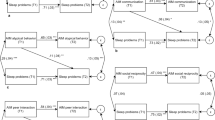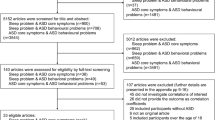Abstract
We explored possible cognitive, behavioral, emotional, and physiological risk markers for sleep disturbance in children with autism spectrum disorders. Data from 1,583 children in the Autism Treatment Network were analyzed. Approximately 45 potential predictors were analyzed using hierarchical regression modeling. As medication could confound findings, it was included in the analyses as a covariate. Results revealed that anxiety, autism symptom severity, sensory sensitivities, and GI problems were associated with sleep disturbance. IQ positively predicted sleep disturbance, and children with Asperger’s Disorder were more vulnerable than others. The amount of variance in sleep outcomes explained by predictor variables was modest (i.e., R 2 from .104 to .201). Predictor variables were evaluated in the context of a bidirectional theoretical framework.

Similar content being viewed by others
References
Acebo, C., Sadeh, A., Seifer, R., Tzischinsky, O., Hafer, A., & Carskadon, M. A. (2005). Sleep/wake patterns derived from activity monitoring and maternal report for healthy 1- to 5-year-old children. Sleep, 28, 1568–1577.
Achenbach, T. M. (1991). Manual for the child behavior checklist 4–18 and 1991 profile. Burlington, VT: University of Vermont, Department of Psychiatry.
Allik, H., Larsson, J., & Smedje, H. (2006). Insomnia in school-age children with Asperger’s syndrome or high-functioning autism. BMC Psychiatry, 28, 6–18.
American Psychiatric Association (2000). Diagnostic and statistical manual of mental disorders, (4th ed., text revision). Washington, DC: American Psychiatric Association.
Autism Treatment Network Collaboration. (2010). Autism treatment network patient registry annual report. Autism Speaks Foundation (Unpublished annual report).
Bruni, O., Ferri, R., Vittiorie, E., Novelli, L., Vignati, M., & Porfirio, M. C. (2007). Sleep architecture and NREM alterations in children and adolescents with Asperger’s Syndrome. Sleep, 30, 1577–1585.
Carskadon, M. A., & Acebo, C. (2002). Regulation of sleepiness in adolescents: Update, insights, and speculation. Sleep, 25, 606–614.
Cohen, J. (1988). Statistical power analysis for the behavioral sciences (2nd ed.). London: Lawrence Erlbaum Associates.
Cohen, J., Cohen, P., West, S. G., & Aiken, L. S. (2003). Applied multiple regression/correlation analysis for the behavioral sciences (3rd ed.). Mahwah, NJ: Lawrence Earlbaum Associates, Inc., Publishers.
Dan, B., & Boyd, S. G. (2006). A neurophysiological perspective on sleep and its maturation. Developmental Medicine and Child Neurology, 48, 773–779.
Dahl, R. E., & Harvey, A. G. (2007). Sleep in children and adolescents with behavioral and emotional disorders. Sleep Medicine Clinics, 2, 501–511.
Diomedi, M., Curatolo, P., Scalise, A., Placidi, F., Caretto, F., & Gigli, G. L. (1999). Sleep abnormalities in mentally retarded autistic subjects: Down’s Syndrome with mental retardation, and normal subjects. Brain and Development, 21, 548–553.
Dunn, W. (1999). The sensory profile manual. San Antonio: The Psychological Corporation.
Ehlers, S., Gillberg, C., & Wing, L. (1999). A screening questionnaire for Asperger Syndrome and other high-functioning autism spectrum disorders in school age children. Journal of Autism and Developmental Disorders, 29, 129–141.
Ferguson, C. J. (2009). An effect size primer: A guide for clinicians and researchers. Professional Psychology: Research and Practice, 40, 532–545.
Gabriels, R. L., Cuccaro, M. L., Hill, D. E., Ivers, B. J., & Goldson, E. (2005). Repetitive behaviors in autism: Relationships with associated clinical features. Research in Developmental Disabilities, 26, 169–181.
Giannotti, F., Cortesi, F., Cerquiglini, A., Miraglia, D., Vagnoni, C., Sebastiani, T., et al. (2008). An investigation of sleep characteristics, EEG abnormalities and epilepsy in developmentally regressed and non-regressed children with autism. Journal of Autism and Developmental Disorders, 38, 1888–1897.
Giannotti, F., Cortesi, F., Cerquiglini, A., Vagnoni, C., & Valente, D. (2011). Sleep in children with Autism with and without autistic regression. Journal of Sleep Research, 20, 338–347.
Goldman, S. E., Richdale, A. L., Clemmons, T., & Malow, B. A. (2012). Parental sleep concerns in autism spectrum disorders: Variations from childhood to adolescence. Journal of Autism and Developmental Disorders, 42, 531–538.
Goldman, S. E., Surdyka, K., Cuevas, R., Adkins, K., Wang, L., & Malow, B. A. (2009). Defining the sleep phenotype in children with autism. Developmental Neuropsychology, 43, 560–573.
Gotham, K., Risi, S., Dawson, G., Tager-Flusberg, H., Joseph, R., Carter, A., et al. (2008). A replication of the autism diagnostic observation schedule (ADOS) revised algorithms. Journal of the American Academy of Child and Adolescent Psychiatry, 47, 642–651.
Haftgoli, N., Favrat, B., Verdon, F., Vaucher, P., Bischoff, T., Burnand, B., et al. (2010). Patients presenting with somatic complaints in general practice: Depression, anxiety and somatoform disorders are frequent and associated with psychosocial stressors. BMC Family Practice, 11, 67.
Harvey, M. T., & Kennedy, C. H. (2002). Polysomnographic phenotypes in developmental disabilities. International Journal of Developmental Neuroscience, 20, 443–448.
Hollway, J. A., & Aman, M. G. (2011a). Pharmacological treatment of sleep disturbance in children with developmental disabilities. Research in Developmental Disabilities, 32, 939–962.
Hollway, J. A., & Aman, M. G. (2011b). Correlates of sleep disturbance in children with pervasive developmental disorders. Research in Developmental Disabilities, 32, 1399–1421.
Hughes, A. A., Lourea-Waddell, B., & Kendall, P. C. (2008). Somatic complaints in children with anxiety disorders and their unique prediction of poorer academic performance. Child Psychiatry and Human Development, 39, 211–220.
Ivanenko, A., Crabtree, V. M., & Gozal, D. (2004). Sleep in children with psychiatric disorders. Pediatric Clinics of North America, 51, 51–68.
Johnson, K. P., Giannotti, F., & Cortesi, G. (2009). Sleep patterns in autism spectrum disorders. Child and Adolescent Psychiatric Clinics of North America, 18, 917–928.
Kotagal, S. (2007). Sleep in children at risk. Sleep Medicine Clinics, 2, 477–490.
Krakowiak, P., Goodlin-Jones, B., Hertz-Picciotto, I., Croen, L. A., & Hansen, R. L. (2008). Sleep problems in children with autism spectrum disorders, developmental delays, and typical development: A population-based study. Journal of Sleep Research, 17, 197–206.
Lajonchere, C., Jones, N., Coury, D. L., & Perrin, J. M. (2012). Leadership in health care, research, and quality improvement for children and adolescents with autism spectrum disorders: Autism Treatment Network and Autism Intervention Research Network on Physical Health. Pediatrics, 130, S62–S68.
Lane, A. E., Young, R. L., & Baker, A. E. Z. (2010). Sensory processing subtypes in autism: Association with adaptive behavior. Journal of Autism and Developmental Disorder, 40, 112–122.
Leech, N. L., Barrett, K. C., & Morgan, G. A. (2005). SPSS for intermediate statistics: Use and interpretation (2nd ed.). Mahwah, NJ: Lawrence Earlbaum Associates, Inc., Publishers.
Limoges, E., Laurent, M., Bolduc, C., Berthiaume, C., & Godout, R. (2005). Atypical sleep architecture and the autism phenotype. Brain, 128, 1049–1061.
Little, R. J. (1988). A test of missing completely at random for multivariate data with missing values. Journal of the American Statistical Association, 83, 1198–1202.
Liu, X., Hubbard, J. A., Fabes, R. A., & Adam, J. B. (2006). Sleep disturbances and correlates of children with autism spectrum disorders. Child Psychiatry and Human Development, 37, 179–191.
Lord, C., Rutter, M., DiLavore, P., & Risi, S. (2001). Autism diagnostic observation schedule (ADOS) manual. Los Angeles, CA: Western Psychological Services.
Malow, B. A., Marzec, M. L., McCrew, S. G., Wang, L., Henderson, L. M., & Stone, W. L. (2006). Characterizing sleep in child with autism spectrum disorders: A multidimensional approach. Sleep, 29, 1563–1571.
Maski, K. P., Jeste, S. S., & Spence, S. J. (2011). Common neurological co-morbidities in autism spectrum disorders. Current Opinion in Pediatrics, 23, 609–615.
Mayes, S. D., & Calhoun, S. (2009). Variables related to sleep problems in children with autism. Research in Autism Spectrum Disorder, 3, 931–941.
McGrew, S., Malow, B. A., Henderson, L., Wang, Lily., Song, Y., & Stone, W. L. (2007). Developmental and behavioral questionnaire for autism spectrum disorders. Pediatric Neurology, 37, 108–116.
Meilleur, A. A. S., & Fombonne, E. (2009). Regression of language and non-language skills in pervasive developmental disorders. Journal of Intellectual Disability Research, 15, 115–124.
Meltzer, L. J., & Mindell, J. A. (2008). Behavioral sleep disorders in children and adolescents. Sleep Medicine Clinics, 3, 269–279.
Mindell, J. A. (1993). Sleep Disorders in Children. Health Psychology, 12(2), 151–162.
Mullen, E. M. (1995). Mullen scales of early learning (AGS ed.). Circle Pines, MN: American Guidance Service Inc.
Nixon, G. M., Thompson, J. M. D., Han, D. Y., Becroft, D. M., Clark, P. M., Robinson, E., et al. (2008). Short sleep duration in middle childhood: Risk factors and consequences. Sleep, 31, 71–78.
Ohayon, M. M., Carskadon, M. A., Guilleminault, C., & Vitiello, M. V. (2004). Meta-analysis of quantitative sleep parameters from childhood to old age in healthy individuals: Developing normative sleep values across the human lifespan. Sleep, 27, 1255–1273.
Owens, J. A., Spirito, A., & Mcguinn, M. (2000). The children’s sleep habits questionnaire (CSHQ): Psychometric properties of a survey instrument for school-aged children. Sleep, 23, 1043–1051.
Owens, J. A., & Witmans, M. (2004). Sleep problems. Current Problems in Pediatric and Adolescent Health Care, 34, 155–179.
Patzold, L. M., Richdale, A. L., & Tonge, B. J. (1998). An investigation into sleep characteristics of children with autism and Asperger’s Disorder. Journal of Pediatric Child Health, 34, 528–533.
Reid, G. J., Huntley, E. D., & Lewin, D. S. (2009). Insomnias of childhood and adolescence. Child and adolescent Clinics of North America, 18, 979–1000.
Roid, G. H. (2003). Stanford-Binet Intelligence Scales (5th ed.). Itasca, IL: Riverside Publishing.
Schreck, K. A., Mulick, J. A., & Smith, A. F. (2004). Sleep problems as possible predictors of intensified symptoms of autism. Research in Developmental Disabilities, 25, 57–66.
Sparrow, S. S., Balla, D. A., & Cicchetti, D. V. (1984). Vineland adaptive behavior scales: Survey form manual. Circle Pines: American Guidance Service.
Stein, L. I., Polido, J. C., Mailoux, Z., Coleman, G. G., & Cermack, S. A. (2011). Oral care and sensory sensitivities in children with autism spectrum disorders. Special Care Dentistry, 31, 103–110.
Tani, P., Lindberg, N., Nieminen-von Wendt, L., Appleberg, B., et al. (2003). Insomnia is a frequent finding in adults with Asperger’s Disorder. BMC Psychiatry, 3, 1–10.
Taylor, M. A., Schreck, K. A., & Mulik, J. A. (2012). Sleep disruption as a correlate to cognitive and adaptive behavior problems in autism spectrum disorders. Research in Developmental Disabilities, 33, 1408–1417.
Touchette, E., Petit, D., Tremblay, R. E., & Montplaisir, J. Y. (2009). Risk factors and consequences of early childhood dysomnia: New perspectives. Sleep Medicine Reviews, 13, 355–361.
Williams, P. G., Sears, L. L., & Allard, A. M. (2004). Sleep problems in children with autism. Journal of Sleep Research, 13, 265–268.
Acknowledgments
We gratefully acknowledge the Autism Treatment Network and their study participants for making these data available for study.
Author information
Authors and Affiliations
Corresponding author
Additional information
This manuscript was prepared from a dissertation that was conducted in partial fulfillment of the requirements for the degree of Doctor of Philosophy in the Graduate School of I/DD Psychology at the Ohio State University.
Rights and permissions
About this article
Cite this article
Hollway, J.A., Aman, M.G. & Butter, E. Correlates and Risk Markers for Sleep Disturbance in Participants of the Autism Treatment Network. J Autism Dev Disord 43, 2830–2843 (2013). https://doi.org/10.1007/s10803-013-1830-y
Published:
Issue Date:
DOI: https://doi.org/10.1007/s10803-013-1830-y




